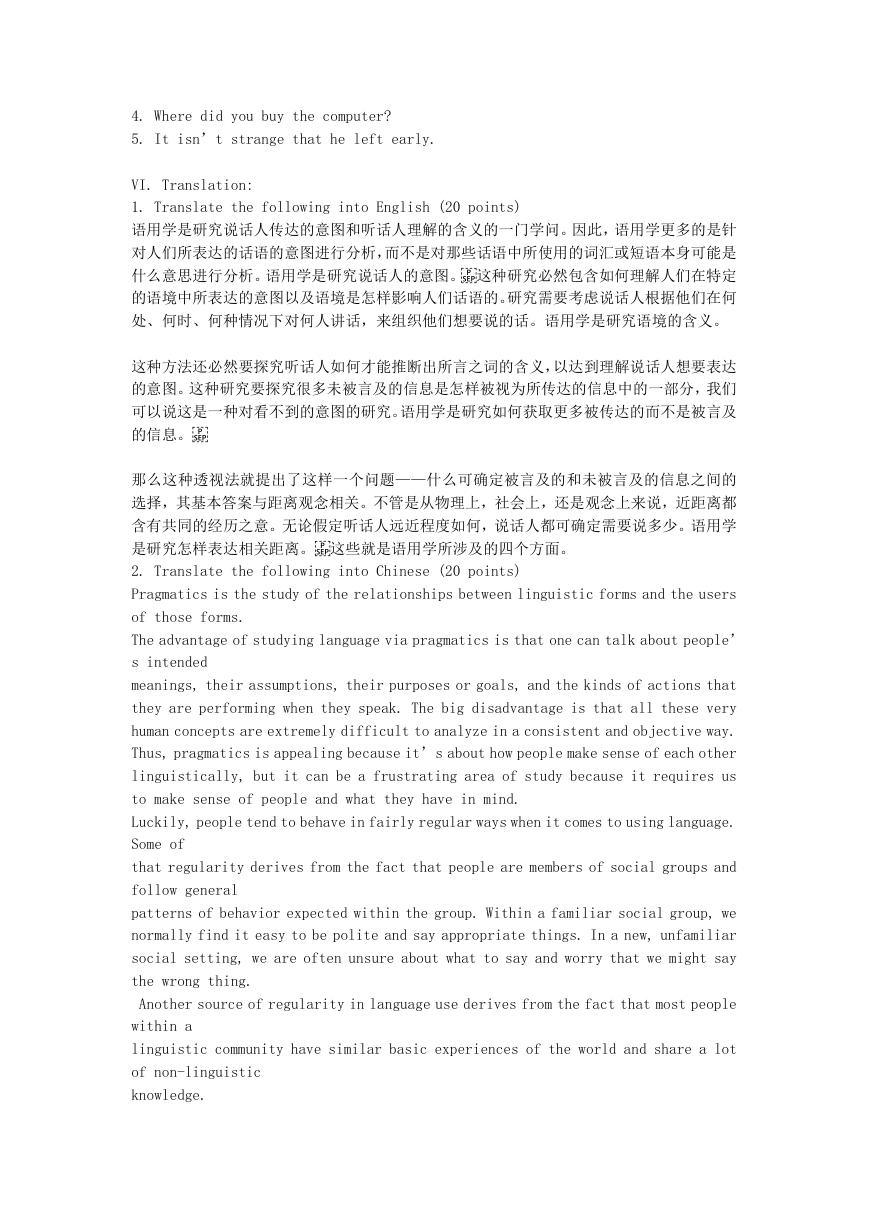2007 年天津工业大学应用语言学考研真题
I. Define the following terms (10 points)
1 morpheme (2 points)
2 minimal pairs (3 points)
3 design features (3 points)
4 competence (2 points)
II. Multiple choice (20 points. 1 point for each item)
1. Who were the ancestors of the English and the founders of England?
A. the Anglo-Saxons B. the Normans C. the Vikings D. the Romans
2. Which of the following king was executed in the civil war?
A. James I B. James II C. Charles I D. Charles II
3. Which of the following is NOT a characteristic of the Open University in Britain?
A. It’s open to everybody.
B. It requires no formal educational qualifications.
C. No university degree is awarded.
D. University courses are followed through TV, radio, correspondence, etc.
4. Under whose reign was the Bill of Rights passed?
A. James II B. William of Orange C. Oliver Cromwell D. George I
5. The general election in Britain is held every ______ years.
A. four B. five C. six D. three
6. It is ______ who served as Prime Minister after Mrs. Margaret Thatcher.
A. Tony Blair B. John Major C. Harold Wilson D. James Callaghan
7. Which of the following description about the Conservative Party is NOT true ?
A. It has been in power for an unusually long period of time.
B. It prefers policies that protect individual’s rights.
C. It receives a lot of the funding from big companies.
D. It is known as a party of high taxation levels.
8. In the examination called the 11 plus, students with academic potential go to
_______.
A. grammar schools B. comprehensive schools
C. public schools D. technical schools
9. In Britain, the term from early September to mid-December is known as _______.
�
IV. Answer the following questions (20 points. 5 points for each item)
1.In what ways can linguistics contribute to the research in language teaching?
2. What are the main features of Chomsky’s TG grammar?
3. Why is Saussure known as the father of modern linguistics?
4. What is the general understanding of the role of grammar in language learning?
V. Read the following passages and answer the questions.
Passage One
To fully understand the meaning of a sentence, we must also understand the context
in which it
was uttered. Take the word ‘ball’ for example:
1. He kicked the ball into the net.
2. She dribbled the ball down the court and shot a basket.
3. He putted the ball in from two feet away.
From the examples given above we know that the word‘ball’is understood in different
ways
depending on what type of action is associated with it. What kind of ball could you
visualize in each
statement? (6 points. 2points for each item)
4. What’s the function of the ‘context’? (4 points)
Passage Two
We have assumed that speakers and listeners involved in conversation are generally
cooperating
with each other. For example, for reference to be successful, it was proposed that
�
collaboration was a
necessary factor. This sense of cooperation is simply one in which people having
a conversation are
not normally assumed to be trying to confuse, trick, or withhold relevant information
form each other.
In most circumstances, this kind of cooperation is only the starting point for making
sense of what is
said. Look at the following dialogues. Write a pragmatic paraphrase in each case.
(15 points. 3 points
for each item)
Example: Maggie: Have you fulfilled your dream?
Jack: Everybody has a dream.
The possible paraphrase: ‘No, I haven’t fulfilled my dream yet.’
1. Mary: Do you like my newly-bought dress?
John: It’s pink.
2. Linda: Would you like some coffee?
Tom: It would keep me awake all night.
3. Jane: Have you finished the reading lists and the term paper?
Mike: I’ve done the term paper.
4. Carol: Are you going to Terry’s birthday party?
Dick: Well, Terry has got two dogs now.
5. Anna: Was the dessert delicious?
Paul: Apple pie is Apple pie.
Passage Three
There was an appeal to the idea that speakers assume certain information is already
known by
their listeners. Because it is treated as known, such information will generally
not be stated and
consequently will count as part of what is communicated but not said. The technical
terms
presupposition and entailment are used to describe two different aspects of this
kind of information.
A presupposition is something the speaker assumes to be the case prior to making
an utterance.
Speakers, not sentences, have presuppositions. An entailment is something that
logically follows from what is asserted in the utterance. Sentences, not speakers,
have entailments.
For each of the following utterances decide what the speakers presuppose? (15 points.
3 pointsfor each item)
Example: We regret telling him.
Presupposition: We told him.
1. He didn’t realize she was ill.
2. Did you tell him the bad news?
3. Stop being lazy.
�
4. Where did you buy the computer?
5. It isn’t strange that he left early.
VI. Translation:
1. Translate the following into English (20 points)
语用学是研究说话人传达的意图和听话人理解的含义的一门学问。因此,语用学更多的是针
对人们所表达的话语的意图进行分析,而不是对那些话语中所使用的词汇或短语本身可能是
什么意思进行分析。语用学是研究说话人的意图。
这种研究必然包含如何理解人们在特定
的语境中所表达的意图以及语境是怎样影响人们话语的。研究需要考虑说话人根据他们在何
处、何时、何种情况下对何人讲话,来组织他们想要说的话。语用学是研究语境的含义。
这种方法还必然要探究听话人如何才能推断出所言之词的含义,以达到理解说话人想要表达
的意图。这种研究要探究很多未被言及的信息是怎样被视为所传达的信息中的一部分,我们
可以说这是一种对看不到的意图的研究。语用学是研究如何获取更多被传达的而不是被言及
的信息。
那么这种透视法就提出了这样一个问题——什么可确定被言及的和未被言及的信息之间的
选择,其基本答案与距离观念相关。不管是从物理上,社会上,还是观念上来说,近距离都
含有共同的经历之意。无论假定听话人远近程度如何,说话人都可确定需要说多少。语用学
是研究怎样表达相关距离。
这些就是语用学所涉及的四个方面。
2. Translate the following into Chinese (20 points)
Pragmatics is the study of the relationships between linguistic forms and the users
of those forms.
The advantage of studying language via pragmatics is that one can talk about people’
s intended
meanings, their assumptions, their purposes or goals, and the kinds of actions that
they are performing when they speak. The big disadvantage is that all these very
human concepts are extremely difficult to analyze in a consistent and objective way.
Thus, pragmatics is appealing because it’s about how people make sense of each other
linguistically, but it can be a frustrating area of study because it requires us
to make sense of people and what they have in mind.
Luckily, people tend to behave in fairly regular ways when it comes to using language.
Some of
that regularity derives from the fact that people are members of social groups and
follow general
patterns of behavior expected within the group. Within a familiar social group, we
normally find it easy to be polite and say appropriate things. In a new, unfamiliar
social setting, we are often unsure about what to say and worry that we might say
the wrong thing.
Another source of regularity in language use derives from the fact that most people
within a
linguistic community have similar basic experiences of the world and share a lot
of non-linguistic
knowledge.
�
The types of regularities just described are extremely simple examples of language
in use which are largely ignored by most linguistic analyses.
�










 2023年江西萍乡中考道德与法治真题及答案.doc
2023年江西萍乡中考道德与法治真题及答案.doc 2012年重庆南川中考生物真题及答案.doc
2012年重庆南川中考生物真题及答案.doc 2013年江西师范大学地理学综合及文艺理论基础考研真题.doc
2013年江西师范大学地理学综合及文艺理论基础考研真题.doc 2020年四川甘孜小升初语文真题及答案I卷.doc
2020年四川甘孜小升初语文真题及答案I卷.doc 2020年注册岩土工程师专业基础考试真题及答案.doc
2020年注册岩土工程师专业基础考试真题及答案.doc 2023-2024学年福建省厦门市九年级上学期数学月考试题及答案.doc
2023-2024学年福建省厦门市九年级上学期数学月考试题及答案.doc 2021-2022学年辽宁省沈阳市大东区九年级上学期语文期末试题及答案.doc
2021-2022学年辽宁省沈阳市大东区九年级上学期语文期末试题及答案.doc 2022-2023学年北京东城区初三第一学期物理期末试卷及答案.doc
2022-2023学年北京东城区初三第一学期物理期末试卷及答案.doc 2018上半年江西教师资格初中地理学科知识与教学能力真题及答案.doc
2018上半年江西教师资格初中地理学科知识与教学能力真题及答案.doc 2012年河北国家公务员申论考试真题及答案-省级.doc
2012年河北国家公务员申论考试真题及答案-省级.doc 2020-2021学年江苏省扬州市江都区邵樊片九年级上学期数学第一次质量检测试题及答案.doc
2020-2021学年江苏省扬州市江都区邵樊片九年级上学期数学第一次质量检测试题及答案.doc 2022下半年黑龙江教师资格证中学综合素质真题及答案.doc
2022下半年黑龙江教师资格证中学综合素质真题及答案.doc